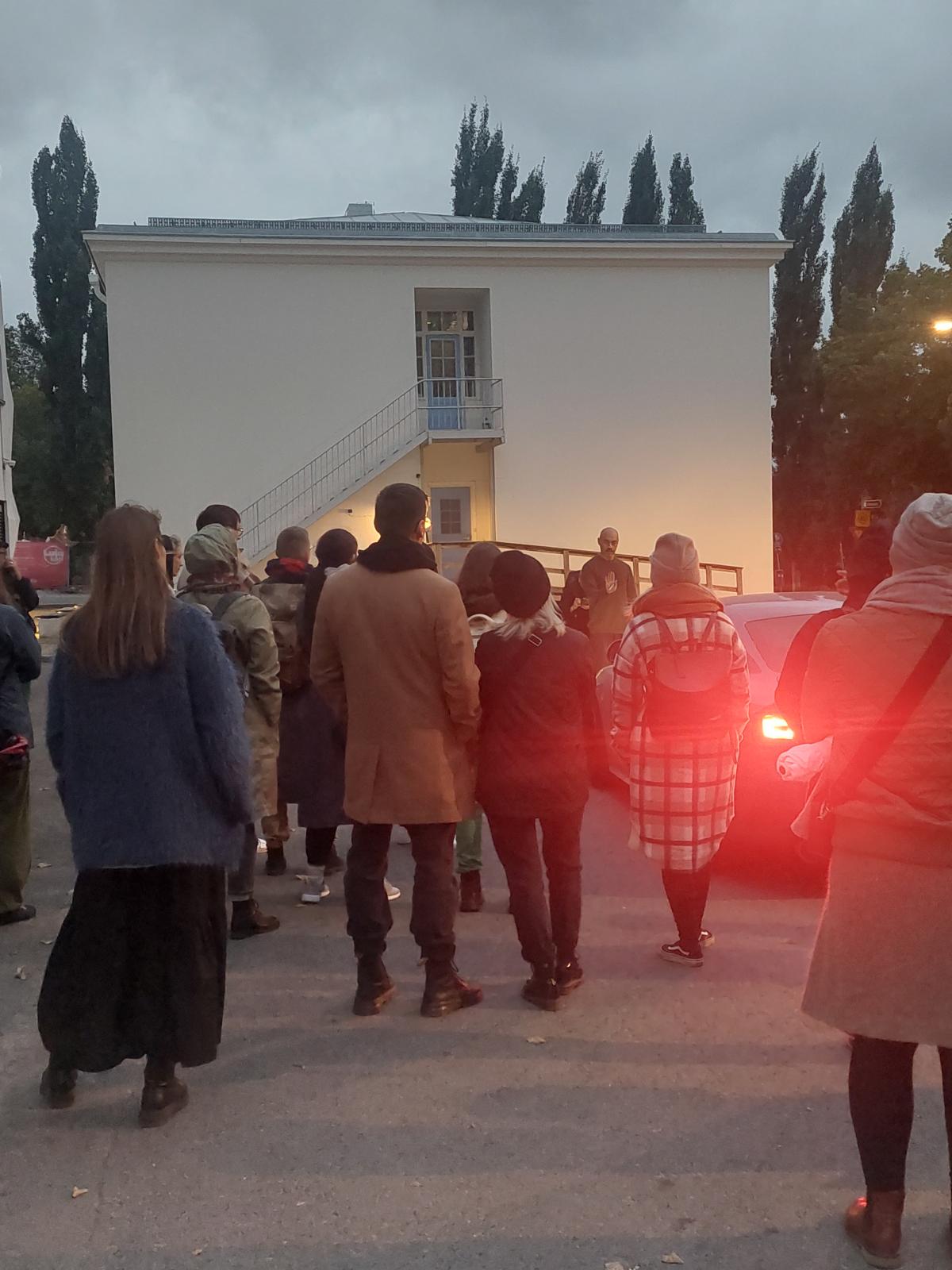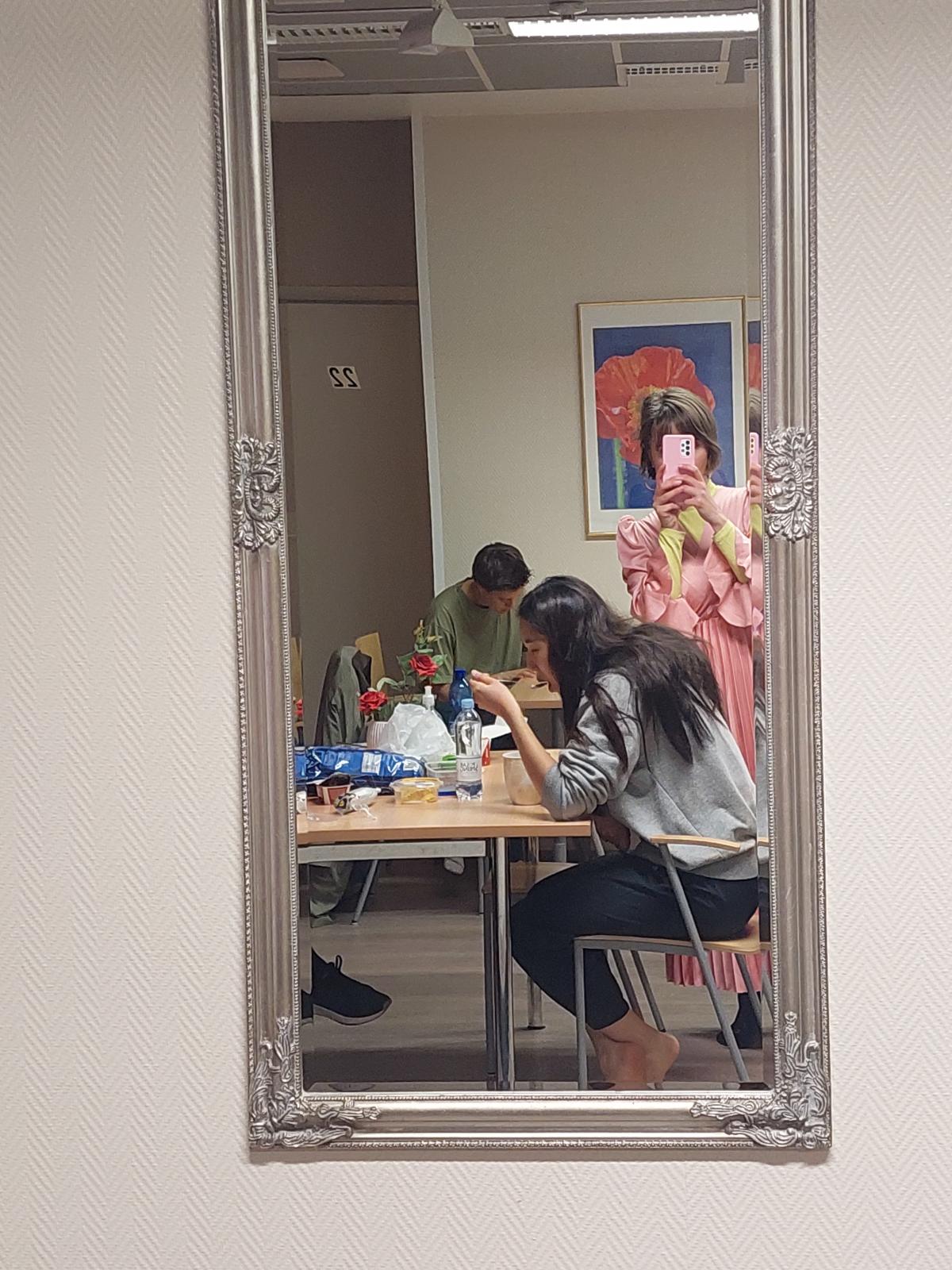ANTI festival 2022
Written by Tina Jeranko, student in Live Art and Performance Studies.
Hungry for performances containing quality.
The workshop on Sexuality, Nudity, and Gender ends with demo performances by all the LAPS students. Short and sweet, one by one, practicing performing and spectatorship with each other, peer-to-peer relation, this is a test so don’t judge.
At around the same time on the next day, we are all sitting on the train from Helsinki to Kuopio for our “field trip” to be part of an international contemporary art festival, focused on the live art event. Live art is an umbrella term for innovative performance art that includes artwork that is performative, participatory and embedded in the present moment. Intermission, it is cold and windy, people are gathering in the parking lot, I enter the performance when it has already begun or maybe it started a couple of seconds ago, although I am on time according to the schedule. One should book a ticket online, however, it is free of charge as all the other shows at the festival, and one could enter that performance from another corner without a ticket check since we are outdoors, and there is no fence around. Brian Fuata, the performer, is having a monologue, moving his body in a precise manner as a trained dancer would, moving us, the audience, making us follow him, follow the car; Audi with a young driver inside, electronic music leaking through the narrow cracks of the car. We enter a grass yard, a permanent concrete block as a stage in the middle, now following the performer into the Kuopio City Theater where eventually one of the shows (Of Mice and Men) in the theater has an intermission. The traditional theater audience and that of contemporary performance look at each other: spectators vs spectators, perhaps spectating spectatorship, as part of the performance.

Despite Kuopio being a small town, we take a shuttle bus to see Last Night of the Deer by Jānis Balodis & Nahuel Cano a village house. Most of the venues are within walking distance from the city center, the works of artists … take over public and private spaces in the city, including homes, shops, market squares, companies, business premises, forests and lakes.
At Hotel Scandic, in a pretty conference room with a view //Snellman Hall is perfectly suited for organizing meetings, dinners, seminars and trainings, // a three-hour-long performance Fixit takes place. At the entrance, I receive the script for the piece which helps me to follow, orientate, and/or focus when the show gets hectic. With lyrics inside, I can sing along if I wish, it is like a gig. Gig research, a research gig, a tryout, “I do performances to see how they play out, not to do it good or bad, just to see how it plays out.” How far should an artist go with their research, how does an immense amount of information and “facts” look like, how relevant is in-depth reading research for this performance, how to translate it into a performance, address the topic ethically, politically correct, and manage to bring some of the concerns, thoughts, and feelings to the audience, touching the subjects of NATO, EU, Cold War, I wondered: How does theory turn into art? History -> Beauty???
Listening to the artist’s distorted voice, Kaino Wennerstrand – a rare local (Fin) artist among international artists presented at the festival – makes me think of HIM (His Infernal Majesty)// a sinister, demonic villain who loves nothing more than chaos and destruction // from superhero animated television series Powerpuff Girls. Pink cake with a NATO sign on it and coffee are served during the break.
I want to dance after, probably influenced by the music from the performance, //electronic music, synth-pop// all our group feels like dancing, yet no opportunity seems to arise. Instead, lapses take a long walk in the rain and wind, gathered in couples under umbrellas. O and I enter a passionate discussion about the piece, should an artist be an expert on the topics they are dealing with, what are our skills as performance artists, and where we acquire them. Professional amateurs. When we introduce ourselves to other professionals and within the applications we write for open calls and grants, do we mention experiences we have for which we don’t have certificates but have been paid for? Or the ones that didn’t happen within an institution, yet they are relevant to (development of) our practice? We have a tendency not to mention these within our applications, how come? Prioritizing what is commonly agreed as an official document, has more value, and institutional weight maybe. Site and context.
Without a reserved ticket – the show is fully booked (popular) – I and other lapses take a 45 min walk from our base, hostel Hermanni, to the venue of Black on Black, we will stand in a waiting queue, counting on no-show // failure to show up//. One stop on the way, Ale Pupi bar, our boost station, a regular one during the days in Kuopio. The venue was at the industrial site, indoor where the Prize ceremony and the closing party of the ANTI festival were organized at the end. The artist Zinzi Minott took me by surprise, she left the stage after about 10 or 15 min of her performance and didn’t return until the end, the audience was left behind for approximately another half an hour with arousing music and a video installation on two screens. I started wondering is it on purpose, is she feeling alright, checking if the audio technicians behind me show any concern. They don’t seem to worry. Plant/s (vague memory) in the right corner of the stage came to my attention, I thought of going on the stage and dancing to the music, feeling disturbed by my own idea, it would be rude. Or would it? Provocative possibly, to be left there watching the repetition of the videos, stage empty of the performer’s physical presence, sitting on the edge of my chair, will her performance continue eventually? Will I miss the great comeback if I leave? Everyone else is sitting, watching the spectacle of no return.

For a change, our days aren’t packed with activities (like they were in Kassel at Documenta 15). No scheduled discussion, they unravel spontaneously after the shows, no need to wake up early and be active with my criticality, and no pressure to see all the shows, to show up in every possible venue.
It is a pleasure and privilege to see performances that have been worked on for a longer period of time and have been financially supported as I have the chance to examine them with my peers. Staying together in a hostel with a shared kitchen and dining area offered us a continuous common space where we could reflect, discuss, and gossip about the hot topics that came along. “No, you must take a big bite to be able to taste it properly.” Indulge, a misplaced intermezzo.
When performance
The master’s programme in Live Art and Performance Studies (LAPS) was launched in 2001 as a Finnish-language degree programme, Esitystaiteen ja -teorian koulutusohjelma. Since 2013, LAPS has been an English-language, international and residential MA programme based in Helsinki. The objective of the programme is to enable artists coming from different environments, classes, cultures and upbringings to focus on their work, develop their research and map out the future of their artistic practice. This blog discloses the various aspects of the LAPS programme, from individual notions and statements by students to providing background for LAPS MA thematic interests.
Learn more about the LAPS programme
Latest posts
Follow blog